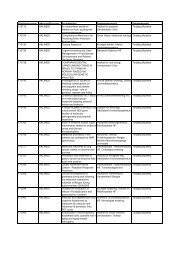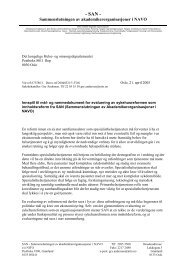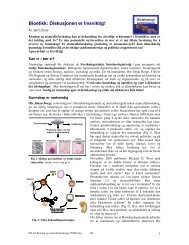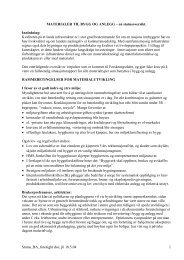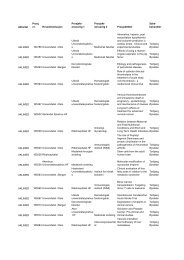A Revolution in R&D
A Revolution in R&D
A Revolution in R&D
Create successful ePaper yourself
Turn your PDF publications into a flip-book with our unique Google optimized e-Paper software.
56<br />
The formidable operational and organizational<br />
changes will entail cultural changes too: <strong>in</strong> fact, the<br />
new processes and structures may prove far less difficult<br />
to establish than new habits and attitudes.<br />
Consider <strong>in</strong>formatics. It is not enough simply to<br />
<strong>in</strong>troduce powerful new IT tools with<strong>in</strong> traditional<br />
silos—with<strong>in</strong> chemistry, for example, where <strong>in</strong> silico<br />
approaches would boost the efficiency of screen<strong>in</strong>g<br />
and optimization. To achieve their full impact,<br />
these IT tools need to be deployed across functions:<br />
to br<strong>in</strong>g biologists and chemists together, to <strong>in</strong>corporate<br />
data from the cl<strong>in</strong>ic <strong>in</strong>to discovery, and so<br />
on. And that will require not just new software, or<br />
even new managerial positions, but new ways of<br />
th<strong>in</strong>k<strong>in</strong>g and of relat<strong>in</strong>g to colleagues.<br />
Some idea of what lies <strong>in</strong> store can be gleaned from<br />
the history of another transformational technology—CAD/CAM<br />
for airplane design. Like<br />
genomics, it promised to transform a costly and<br />
labor-<strong>in</strong>tensive R&D process <strong>in</strong>to a highly automated<br />
and efficient one. After languish<strong>in</strong>g <strong>in</strong> niche<br />
applications <strong>in</strong> the 1970s and ’80s, it f<strong>in</strong>ally proved<br />
its worth <strong>in</strong> the 1990s, when Boe<strong>in</strong>g used it <strong>in</strong><br />
design<strong>in</strong>g the first “paperless” airplane, the Boe<strong>in</strong>g<br />
777. To exploit the technology fully, the company<br />
had to break down departmental barriers and<br />
encourage collaboration across the full range of<br />
functions. Jobs and job responsibilities had to<br />
change. Cherished traditions were called <strong>in</strong>to question.<br />
The company held quarterly meet<strong>in</strong>gs at<br />
which employees could ask questions and voice<br />
their concerns. The transformation was a struggle,<br />
but ultimately a great success: Boe<strong>in</strong>g cont<strong>in</strong>ues to<br />
push the envelope <strong>in</strong> “<strong>in</strong> silico” airplane design.<br />
When pharmaceutical companies convert to genomics,<br />
they will have to temper the discomforts of<br />
transition <strong>in</strong> their turn. And that means engag<strong>in</strong>g<br />
the emotional and behavioral issues—the human<br />
issues—as deeply as the operational ones. 4 Attentive<br />
management of the human issues, which has played<br />
such a prom<strong>in</strong>ent role <strong>in</strong> so many <strong>in</strong>dustries <strong>in</strong> the<br />
throes of reform, is go<strong>in</strong>g to be particularly crucial<br />
when it comes to the massive <strong>in</strong>stitutional changes<br />
demanded by the genomics revolution.<br />
A F<strong>in</strong>al Word<br />
To stake a claim <strong>in</strong> the chang<strong>in</strong>g biopharmaceutical<br />
landscape, let alone feature prom<strong>in</strong>ently with<strong>in</strong> it, a<br />
company will have to make itself radically amenable<br />
to change. Def<strong>in</strong><strong>in</strong>g a strategy is certa<strong>in</strong>ly a step <strong>in</strong><br />
that direction, and <strong>in</strong>itiat<strong>in</strong>g that strategy is certa<strong>in</strong>ly<br />
a gesture of commitment. But wholehearted<br />
commitment is evidenced not by <strong>in</strong>itiat<strong>in</strong>g the strategy<br />
but rather by ma<strong>in</strong>ta<strong>in</strong><strong>in</strong>g it—that is, monitor<strong>in</strong>g<br />
the new structures and procedures constantly,<br />
respond<strong>in</strong>g to shifts <strong>in</strong> external and <strong>in</strong>ternal circumstances,<br />
and <strong>in</strong>troduc<strong>in</strong>g further changes<br />
repeatedly, aggressive or defensive, as new opportunities<br />
or new challenges arise, though always <strong>in</strong> l<strong>in</strong>e<br />
with the controll<strong>in</strong>g wisdom of the strategy itself.<br />
If the unfamiliar outer landscape provokes feel<strong>in</strong>gs<br />
of unease, so too will a company’s <strong>in</strong>ner landscape,<br />
once all the requisite operational and organizational<br />
changes are <strong>in</strong> place. In particular, the <strong>in</strong>crease<br />
<strong>in</strong> cross-functional activity may be disorient<strong>in</strong>g<br />
for some executives of the old school. Many of<br />
the ancient landmarks, tidy borders, and familiar<br />
categories will no longer be there to give them their<br />
bear<strong>in</strong>gs. Short of attempt<strong>in</strong>g a counterrevolution<br />
or withdraw<strong>in</strong>g <strong>in</strong>to obscurity, they will need to<br />
familiarize themselves with the new terra<strong>in</strong> fairly<br />
promptly—and accept it affirmatively, not grudg<strong>in</strong>gly.<br />
Changes <strong>in</strong> attitude will perhaps prove the<br />
most difficult changes of all to br<strong>in</strong>g about, and a<br />
company’s prosperity could be <strong>in</strong> jeopardy if they<br />
fail to take effect.<br />
4. For a fuller discussion of the emotional aspects of change, read The Change Monster, by Jeanie Daniel Duck, published by Crown <strong>in</strong> 2001.



